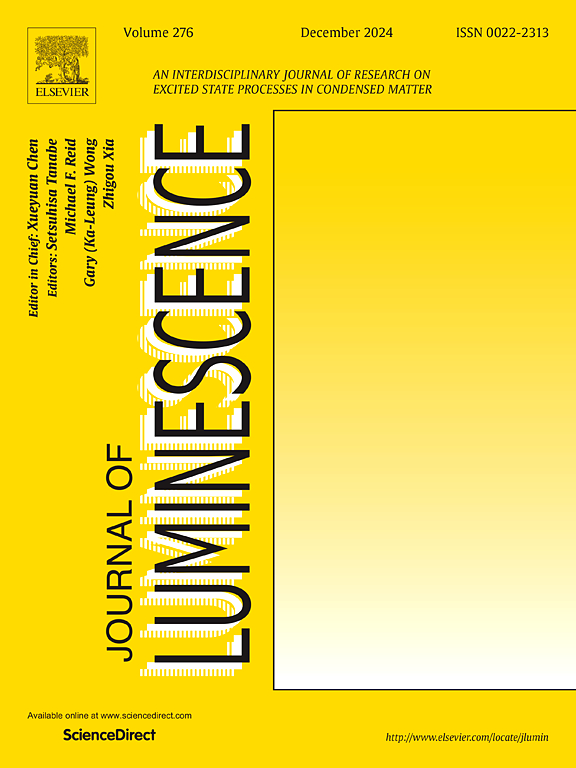Mn-doped Ag2S quantum dots-fluoride hybrid nanostructure for high-sensitivity NIR-II ratiometric thermometry
IF 3.3
3区 物理与天体物理
Q2 OPTICS
引用次数: 0
Abstract
Nanothermometers enable the detection of temperature changes at the microscopic scale, which is crucial for elucidating biological mechanisms and guiding treatment strategies. To address the limited sensitivity of thermally coupled level (TCL)-based nanothermometers, we introduce a defect-engineered NIR-II ratiometric probe by integrating temperature-insensitive NaYF4:Nd@NaYF4 core-shell nanocrystals (NPs) with Mn-doped Ag2S quantum dots (QDs). The Mn2+ doping introduces Ag + vacancies in Ag2S, enhancing thermal quenching via phonon-assisted nonradiative recombination. The resulting NaYF4:Nd@NaYF4-Mn: Ag2S@SiO2 nanocomposite exhibits a record-high relative sensitivity of 2.1 % K−1 at 323 K, surpassing our previous work (0.81 % K−1, Du et al., 2024) and TCL-based sensors. Moreover, the SiO2 matrix not only encapsulates and protects the fluoride nanocrystals and quantum dots but also shields them from aqueous environments, ensuring outstanding luminescence stability. This preparation method provides ideas for the fabrication of other multifunctional composite probes, and the probe also provides new options for biological imaging and temperature detection.
用于高灵敏度NIR-II比例测温的mn掺杂Ag2S量子点-氟化物杂化纳米结构
纳米温度计能够在微观尺度上检测温度变化,这对于阐明生物机制和指导治疗策略至关重要。为了解决基于热耦合能级(TCL)的纳米温度计灵敏度有限的问题,我们通过将温度不敏感的NaYF4:Nd@NaYF4核壳纳米晶体(NPs)与mn掺杂Ag2S量子点(QDs)集成在一起,引入了一种缺陷工程的NIR-II比例探针。Mn2+掺杂在Ag2S中引入Ag +空位,通过声子辅助非辐射复合增强热猝灭。由此产生的NaYF4:Nd@NaYF4-Mn: Ag2S@SiO2纳米复合材料在323 K时显示出创纪录的相对灵敏度,为2.1% K−1,超过了我们之前的工作(0.81% K−1,Du et al, 2024)和基于tcl的传感器。此外,SiO2基体不仅封装和保护氟化物纳米晶体和量子点,而且还保护它们不受水环境的影响,确保了出色的发光稳定性。该制备方法为其他多功能复合探针的制备提供了思路,也为生物成像和温度检测提供了新的选择。
本文章由计算机程序翻译,如有差异,请以英文原文为准。
求助全文
约1分钟内获得全文
求助全文
来源期刊

Journal of Luminescence
物理-光学
CiteScore
6.70
自引率
13.90%
发文量
850
审稿时长
3.8 months
期刊介绍:
The purpose of the Journal of Luminescence is to provide a means of communication between scientists in different disciplines who share a common interest in the electronic excited states of molecular, ionic and covalent systems, whether crystalline, amorphous, or liquid.
We invite original papers and reviews on such subjects as: exciton and polariton dynamics, dynamics of localized excited states, energy and charge transport in ordered and disordered systems, radiative and non-radiative recombination, relaxation processes, vibronic interactions in electronic excited states, photochemistry in condensed systems, excited state resonance, double resonance, spin dynamics, selective excitation spectroscopy, hole burning, coherent processes in excited states, (e.g. coherent optical transients, photon echoes, transient gratings), multiphoton processes, optical bistability, photochromism, and new techniques for the study of excited states. This list is not intended to be exhaustive. Papers in the traditional areas of optical spectroscopy (absorption, MCD, luminescence, Raman scattering) are welcome. Papers on applications (phosphors, scintillators, electro- and cathodo-luminescence, radiography, bioimaging, solar energy, energy conversion, etc.) are also welcome if they present results of scientific, rather than only technological interest. However, papers containing purely theoretical results, not related to phenomena in the excited states, as well as papers using luminescence spectroscopy to perform routine analytical chemistry or biochemistry procedures, are outside the scope of the journal. Some exceptions will be possible at the discretion of the editors.
 求助内容:
求助内容: 应助结果提醒方式:
应助结果提醒方式:


